David

Everyone, please meet David Titterington (www.davidtitterington.blogspot.com). I have a link to his blog page on the right side of this page. He wrote the story of how we met already on his blog, so I will pass on writing it here. Also, his blog is a beautiful display of art and philosophy and I want you to look at it.
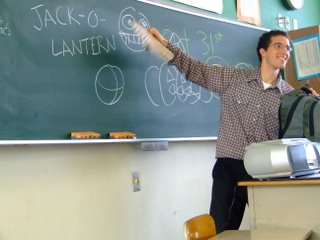
David is a JET teacher in Shikoku. Probably most of you know already, but JET is a program started by the Japanese government to bring native English speakers to Japan to teach alongside Japanese English teachers in an attempt to internationalize Japan. David teaches mostly middle school, and travels to over a dozen different schools throughout the month.
I arrived in Shikoku on a Thursday morning just before the school day was set to begin - and was invited to teach alongside David. We taught students about Halloween.
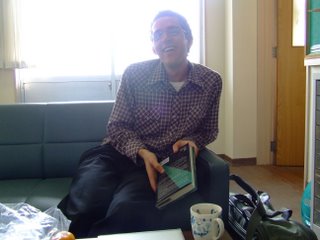
David is also a practicing Tibetan Buddhist. In his hands in this picture is a book called "Integral Spirituality" by Ken Wilber. There is this amazing sense of wonder and charisma that I soak up from sitting across from this beautiful form of flesh and light. He is truly a Bodhisattva - walking around painting images that point out our reality to us.
It's difficult to describe David because it feels like such a shame to use cliche phrases and compliments for him. Once in a great while I meet someone who blows my mind consistently, David is one of those once in a great while people. I think David is also a great mixture of confidence and humor. But maybe the aspect about him I enjoy the most is his flexibility from one situation to another, and the way he literally dances as he moves from place to place.
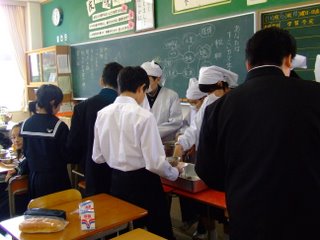
In almost all public schools in Japan, the students serve each other lunch, and all eat the same food. There are some schools I've been told that have a cafeteria, but it seems more common that students eat lunch in their respective classrooms.

There is also a period eveyday before lunch when students clean the school. This includes mopping the floors, cleaning the windows, cleaning the chalkboards and erasers, etc. On this day David and I elected to spend the cleaning period outside, and found a group of boys sweeping, so we joined them.
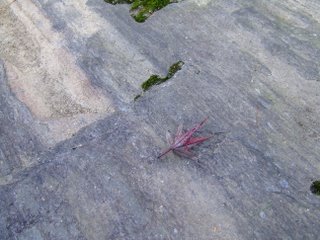
After the school day was over, David took me to a secret zen garden he found. This picture-perfect Japanese garden rivals those you can see in Kyoto, and is just tucked away behind someone's rather large zen temple and adjoining house. Aside from the mosquitos, it would be easy to spend a whole day in this place watching the Koi fish swimming in the pond, listening to the water trickling while lying on the thick, cushy moss surrounded by the wonderful joy that is that quintessential Japanesy feel. The next few pictures are from the secret zen garden.
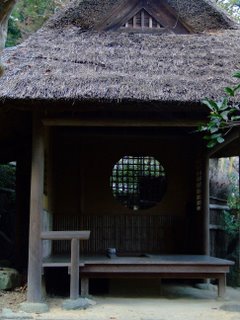
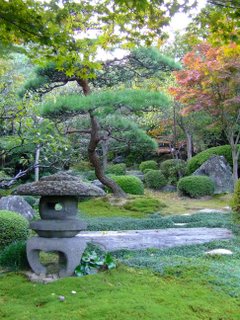
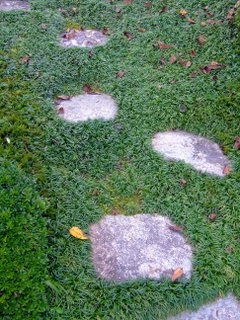
This mossy grass is so soft and thick...it's really what carpet attempts to be.
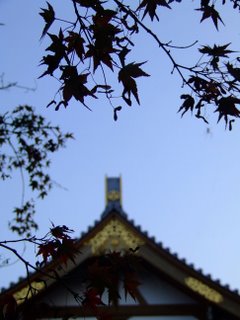
A cheesy shot of a Japanese maple, with the zen temple in the background.
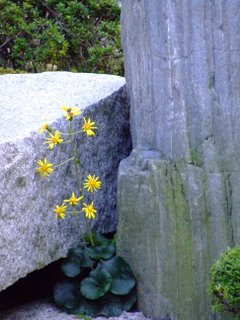

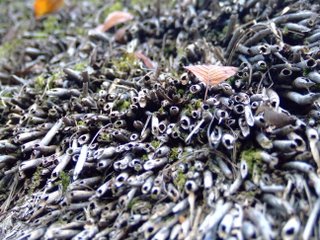
Did you notice the picture earlier of the thatched roof- open walled hut? This is a closeup of the roof. すごいでしょう。

This was our means of transportation - a most amazing Tandem Schwinn. Coincidentally this picture was taken in a shrine complex that has 1000 year old trees. There are small shrines built into some of the trees. Interestingly while we were there, we came across a group of old men hanging out. I thought, yeah, when I'm old and ready to die, where else would be better to socialize than with old, beautiful wrinkly trees and old friends?

When we stopped at the gas station to get some air for the tandem, the station attendants thought it was so cool so they took it for a spin. Honestly, it's these types of moments in Japan that make Japan feel so magical. There is this playful magic about people just about everywhere you go that if uncovered leads to wide smiles and an extremely fine sense of being.
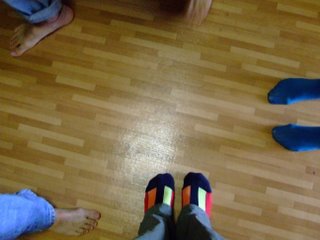
A good friend of mine, once told me something a good friend of her's had told her. She said, the religion we choose to be is how we choose to walk on this earth. Everyonce in awhile, I think it's important to take a look at my feet and see if my idea of how I'm walking on this earth matches my footprints.

I put this picture up of David's refridgerator in case anyone seeing this back in Lawrence can appreciate the people pictured here. There are alot of very beautiful people who were or still are in Lawrence on this fridge. And others from Japan.
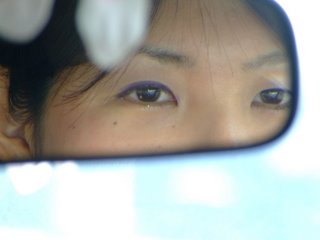
After an amazing vegetarian potluck party at David' apartment that night, we took off the next day for a town called Matsuyama. I met two of David's Japanese friends, Yukiko and Yasu. This is Yukiko, driving us through the Shikoku country-side, and alot of tunnels through the mountains.

Meet Yasu.
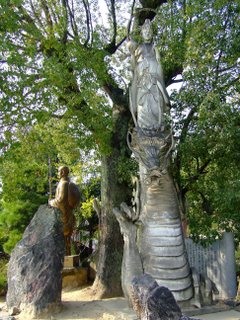
Our first stop in Matsuyama was the 51st temple of the Shikoku 88 temple pilgrimage route. This picture showcases Quan Yin, or Kuan Yin, or Avalokiteshvara, or Kannon or Chenrezig - a rose by any other name is still a rose - the Buddhist diety representing compassion. It is a Bodhisattva often portrayed in the female form, and in this case, riding a huge dragon. Traditionally i think it can be said dragons in the eastern portion of the world are seen as representing wisdom, spiritual power, and are friends rather than foes. Anyway, it was interesting to see the coupling of these two icons.
And by the way, anyone out there wondering what all the fuss is about with that guy named the Dalai Lama, he is in Tibetan Buddhist practitioners' eyes the living incarnation of this Bodhisattva of compassion - Avalokiteshvara. So, it's kind of a big deal. In the Christian sense - it might be equatable to having the holy spirit in the form of a living, breathing human being.
Anyone interested in the Dalai Lama, and his previous 13 existences, there is an entertaining and insightful movie about his training and life called "Kundun." It's also chalk full of interesting tid bits about the historical relationship between Tibet and China during Mao's cultural revolution. The movie made me cry, several times.
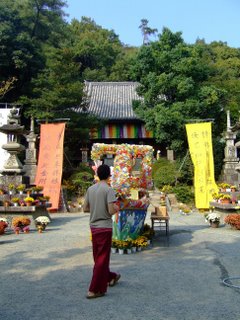
This is the main temple building, with a boat lined with prayers written on papers that are tied to its frame. The boat in Buddhism is an interesting icon that is used quite often as a metaphorical explanatory tool. Buddhism is often likened to a boat that is only a tool to help one cross over the river of ignorance and reach the shore of understanding. When the boat has fulfilled its purpose you leave it - let it go - and keep going. You wouldn't carry a raft with you just because you think you might come across another river. In that way, Buddhism is not a philosophy that is an end in itself. It is a means to help people achieve mental clarity through developing a sturdy foundation of morals, along with the tool of meditation to create an attitude of mindfulness and opennesss that allow one to experience insights into reality and the mind that foster wisdom, compassion and what is referred to as "skillful means." I think of skillful means as being akin to knowing what is the most compassionate in each moment - or what Ken Wilber might say as having the greatest depth for the greatest span.
It was a rather beautiful boat, filled with the kind prayers and wishes of other visitors.
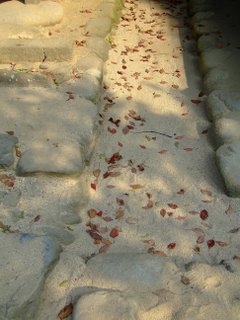
I kep wondering if what I was seeing was real. This place was really like a dream.

Doing the Shikoku 88 temple pilgrimage is a big deal for many people in the Shingon sect of Buddhism here. Even for people who aren't Buddhist, it's a great way to see the island and also see some very interesting traditional aspects of Japanese life.
While we were walking around the temple complex, a man waved us down and told us to come to him, so we did. He motioned to this ledge with the bags and told us to touch them. Each bag is filled with sand from one of the 88 temples. So, even though we weren't able to make the pilgrimage in the space of a few days, we were able to touch each place.
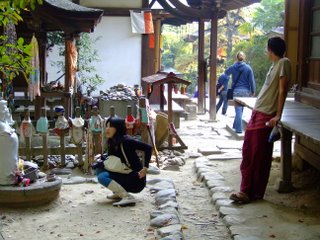
There was so much to see at this temple. Several smaller shrines were located alongside the outskirts of the larger temple rooms. There was also a cave in the back of the temple complex that jutted into the mountain side. Inside were small statues of Buddhas, Bodhisattvas and even a small shrine that had an amazing 3D mandala. David's blog has a nice picture of that - so I'll leave it to you to find it. But if you're curious about a mandala, it's a representative image of the order and structure of the universe according to Buddhist cosmology. It's easier to think of it as a blueprint of the mind. It's generally used as a tool for meditators to orient themselves to the Buddhist world view - and gain a boost for how to relate to reality. It's difficult to explain because mandalas serve a lot of different purposes depending on the context and the type of Buddhism. I'm not so confident in my understanding to say anything more at this time.
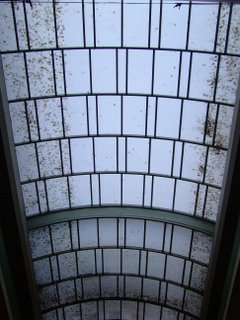
This is the type of picture my parents have dubbed "a Ricky photograph." Yep, it's a Ricky picture allright.
You must already know, dear reader, that in the daily lives we lead, if we are unable to find any beauty in the most ordinary of ordinary things, how sad it must be. That is why I like to take pictures like this - because it always helps me to appreciate the backgrounds and foundations of experience, the props and stage that allow for the drama to unfold.
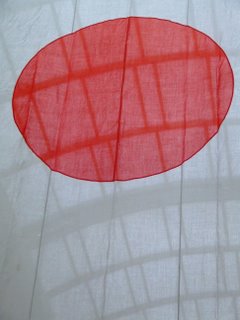
There is still some war-time guilt in Japan which has influenced Japanese attitudes of war and nationalism. There are militarists, nationalists, and people who deny Japan did anything wrong during WWII alive and active in the political arena, but are usually small in number and limited in power. The new prime minister Abe-san, or Shinzo Abe, recently published a book called "A Beautiful Japan." Two things about this are worth mentioning.
The first is that a leading politician, in this case the single most powerful political actor (at least on paper) in Japan published a book. There are some Presidents in the US who have published books, but I know of none that have published books before taking office. I also know of none that have published books that outline their hopes and policy goals for their time in office. I give Abe-san a big thumbs up for the effort, and also for the transparency to the general Japanese populace. Honestly, I can't imagine Mr. Bush publishing his own book.
The second is that in this beautiful Japan Abe-san wants to create, one of the key ideas he proposes is educational reform. He wants to reaffirm a sense of nationalism in Japan in young people by reforming the educational system. Young people he says lack discipline and a sense of love for their country. So, to encourage discipline - we should teach young people in school to love Japan. It's an interesting train of logic that I see serving other purposes than simply fostering discipline.
So, with that in mind, seeing this large Japanese flag inside a shopping mall made me wander about that, and what and where this new sense of nationalism Abe-san wants to affect students with will become and lead Japanese society amidst open discussions about aquiring nuclear weapons and revising article 9 of the constitution (the article that forbids Japan from having offensive military capability).
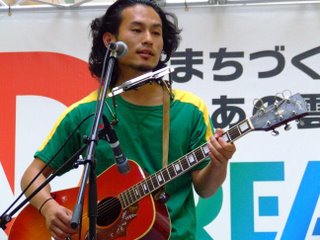
The reason for being in the shopping center, was to watch this guy named Mai, perform. He is really soft-spoken and gentle when he speaks in everyday conversation, but when he performs, it looks like he is channelling some energy that is too intense or too strong to control and his body becomes jerky and jolty with almost a supernatural tension - like he is possessed. I was blown away. It was also my first experience of hearing Japanese folk music with spoken word poetry.
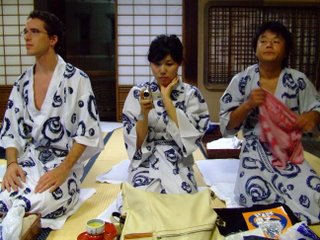
That evening, while still in Matsuyama, we headed down to the very first onsen in Japan called Dogo onsen. The next picture is of the building. Anyone who has been to an onsen can easily understand and appreciate how special onsen time is. There is quite nothing like the experience of getting naked, bathing and soaking in a gigantic bathtub with a group of men, or women. There are some coed onsens in Japan, but it's rather rare. This onsen is rather unique to me in that it had four floors, and there were large sitting areas like this one pictured above where you could sit with your friends, drink tea, eat some Japanese snacks, and enjoy the after-glow of the onsen's bath. I wish you all could experience this - if you get past any feeling of embarrassment or shyness about being naked in front of others - it is one of the most soothing and relaxing feelings I've ever felt.
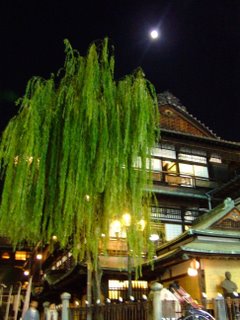

The next day, a group of David's friends and I went to the tallest mountain in Western Japan. Here we are at the base, getting ready to start the trail up the mountain. Like most mountains in Japan there are local kamis, or dieties, that live in the mountain. Well, it's almost impossible to say where they live - if it's in, on or around the mountain. But there are always places to offer prayers, give money or pray to these dieties. David and I offered a candle, which means safety for one's family, and asked for the protection of our group for the time spent on this kami's mountain.
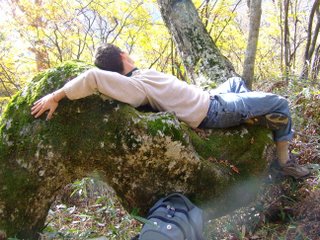
Along the path we came across this moss-covered tree that was shaped like a hammock. How could you not take a little rest?

The moss was so kissably soft...Japanese moss...
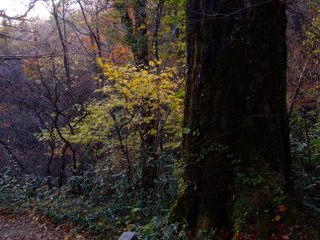
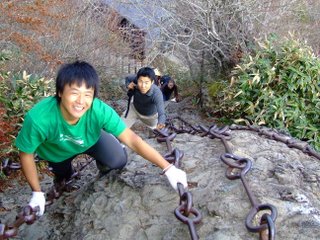
Here is Yasu, and his brother, climbing up one of the sets of iron rings that make it easier to climb up the steeper parts of the mountain. It's hard to get the perspective from this photograph, but it is a vertical cliff.
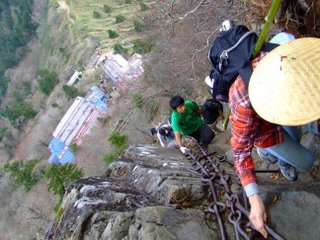
Another iron ring section.

All of the following pictures are taken from the summit.
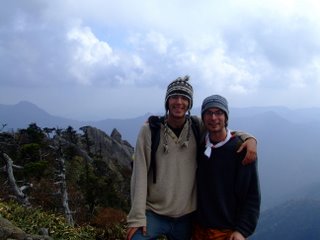
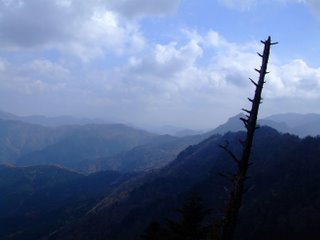
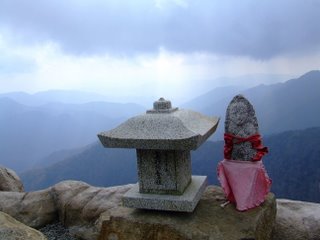
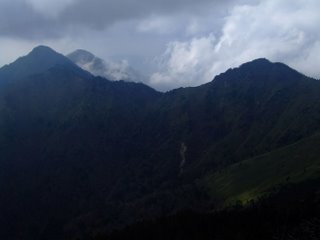
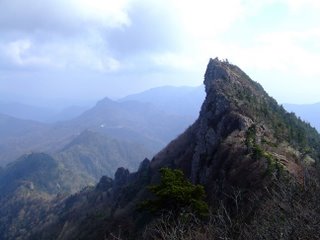
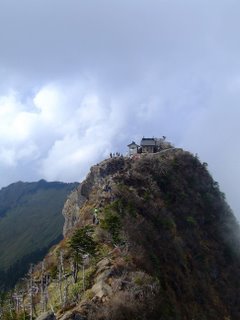
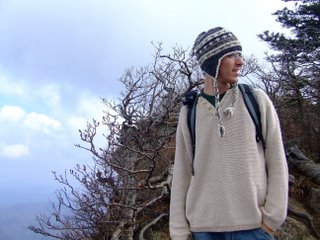
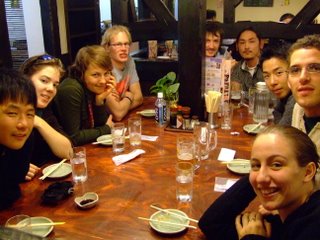
Later that night the climbers and some other friends got together for a Saturday night in Saijou, a town not too far away from David's.
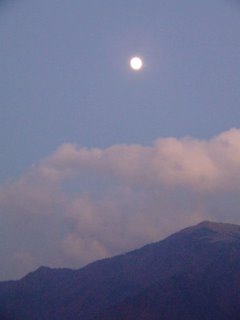

I'm still working on the translation - any suggestions? I can't quite figure out the meaning of ”日ぞなき” and ”すほぬ”.
This was posted at the front entrance of a zen monastery David took me to on Sunday morning for the morning meditation.
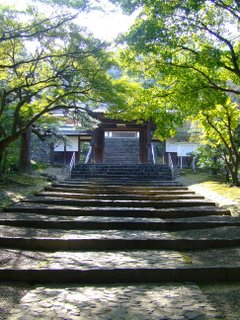
The entrance to the zen monastery.
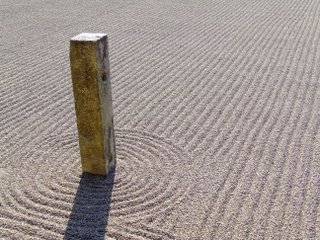
the cheesy picture of the zen rock garden. I wonder though how the circle lines, representing an island and its perimeter in the ocean of life, work into Buddhist philosophy about the nature of the self, distinction and separation? Any thoughts?
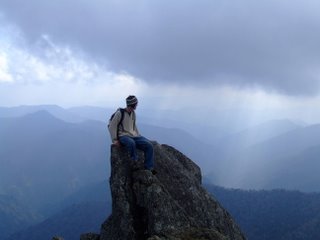
Dear David,
I learn so much from listening to you, seeing your artwork, and experiecing your being. May you have a long and happy life. Thank you for reminding me of some essential things I had forgotten, for helping me look at my footprints. Your joy is like bubble bath soap. A little splash and its little tiny bubbles float around and cleanse whatever they touch. デイビットの程度こそ、四国は天国のように感じれるよ。非常にお世話になりましたね。僕はデイビットに会ったから本当に運がいいと感じるよ。体に心に手にも気を付けて下さいね。

1 Comments:
i miss you so much
Post a Comment
<< Home